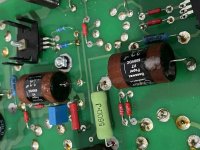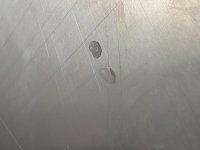Why didn't you use shielded cable to connect the inpuit jacks to the PCB? Were you adviced to do it like you did, i.e. use twisted pairs?
And, comparing your new photos with the three years old ones, where's the component (a capacitor?) that has been inside that hollow metal cylinder?
Best regards!
And, comparing your new photos with the three years old ones, where's the component (a capacitor?) that has been inside that hollow metal cylinder?
Best regards!
Last edited:
Were you adviced to do it like you did, i.e. use twisted pairs?
It is stated on the web site and in the forums that shielded cable is the preferred method for running the input cables. Twisted pair is acceptable in cases where short and direct connections are possible. I have used both and in cases where it can be routed against the metal chassis away from all AC and output wiring, there is no measurable difference in hum.
where's the component (a capacitor?) that has been inside that hollow metal cylinder?
Many builders, including myself choose to add a supplemental LOW ESR capacitor from B+ to ground. This does improve the transient response especially in the upper audio range due to the ESL and ESR of some large value electrolytic caps. The preferred capacitor type is a polypropylene motor RUN (not start) capacitor.
It is advised in the build instructions that first time builders get the basic amp working first before adding any of the extra features, like the supplemental cap, triode/UL switch and cathode feedback switch if desired.
Coupling cap Wax
After some days testing the amp, sound is fantastic, noise and hum completely disappeared. Everything seems perfect except for one thing.
Today I had to open the box to tighten one of the speaker terminals that got a bit loose. When I opened it I could see wax on the bottom of the case. This is coming from the coupling caps (both of them....) that are loosing wax.
Should I worry about it?
Thanks!!
After some days testing the amp, sound is fantastic, noise and hum completely disappeared. Everything seems perfect except for one thing.
Today I had to open the box to tighten one of the speaker terminals that got a bit loose. When I opened it I could see wax on the bottom of the case. This is coming from the coupling caps (both of them....) that are loosing wax.
Should I worry about it?
Thanks!!
Attachments
- Status
- This old topic is closed. If you want to reopen this topic, contact a moderator using the "Report Post" button.
- Home
- More Vendors...
- Tubelab
- R2 fire - blown

